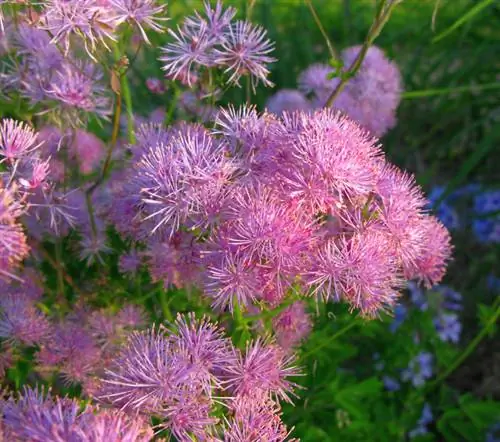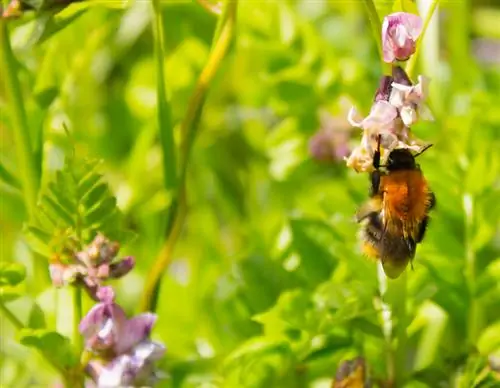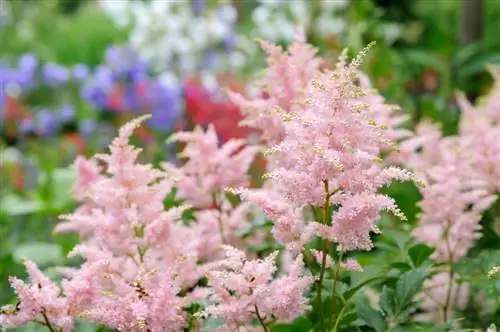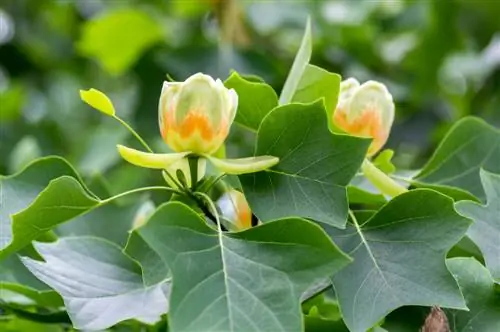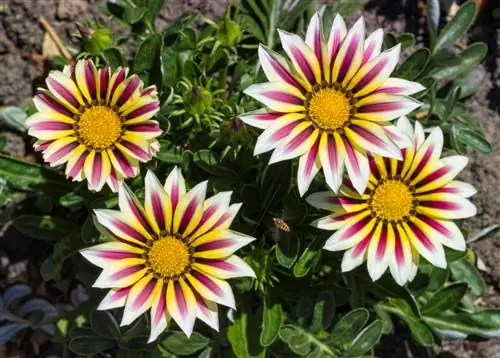- Author admin [email protected].
- Public 2023-12-25 17:45.
- Last modified 2025-01-23 11:21.
The meadow rue have a large distribution area. Their location requirements make them ideal ornamental plants for the garden. They beautify corners of the garden that are avoided by other plants. With proper care, meadow rue will delight you with romantic flowers for years to come.
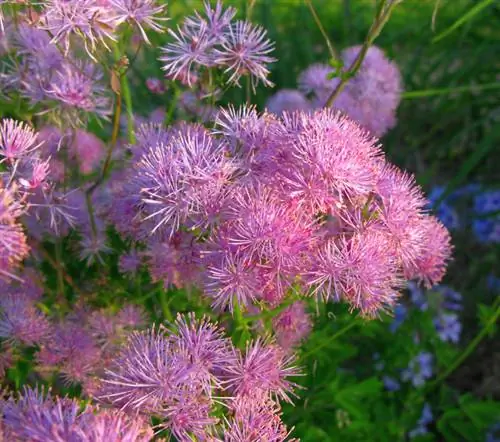
How do I care for meadow rue in the garden?
Meadow rue are perennial, herbaceous plants that are characterized by delicate flowers and elegant foliage. They prefer partially shaded locations and nutrient-rich, humus-rich soil. Care includes regular watering, occasional pruning and spring fertilization. Golden bulbs, rodgersias and ornamental grasses are suitable as neighboring plants.
Origin
The genus of meadow rue with the Latin name Thalictrum includes between 120 and 200 species that are distributed worldwide. The buttercup family is mainly distributed in temperate climate zones. Meadow rue are found in North America, China and Europe. They grow in lowlands and reach altitudes of up to 900 meters.
Their shape is reminiscent of columbines. Outside the flowering period, meadow rue are easily confused with the closely related species. About seven species are cultivated in gardens, including the native columbine meadow rue, which has the botanical name Thalictrum aquilegifolium.
Growth
Meadow rue are herbaceous plants that grow perennial with the help of underground survival organs. The rhizomes and root nodules can become woody. During their growth period, the plants develop into magnificent perennials that can reach heights of up to 180 centimeters.
leaves
Thalictrum species develop both basal and deciduous leaves. These are arranged alternately on the stem. The lower leaves are divided into blades and stalks. Upper stem leaves are sessile and sit directly on the shoot axis. The leaf blade appears one to four times pinnate. Their leaflets are rounded, heart-shaped or kidney-shaped and deeply cut at their tips. A few species produce undivided leaf blades.
Bloom
Meadow rue forms single flowers or inflorescences that can bear between two and 200 small flowers. In most species the inflorescences grow terminally. Their shape is very variable. They can grow up to 40 centimeters long.
The flowers are hermaphroditic or unisexual and appear radially symmetrical. They consist of a simple perianth composed of four to ten perianth petals. These are inconspicuously greenish-yellow or strikingly purple to pink in color. In many species the flower bracts fall off early. The flowering period extends from July to August.
Fruit
After the flowering period, meadow rue develop collective fruits that contain numerous nuts. Some of the nuts are beaked. These structures serve for anchoring. The fruits get caught in the fur of animals.
Usage
The delicate plants are suitable for perennial borders in semi-shady locations. Here the delicate flowers provide subtle accents. They are well suited as leading perennials that are surrounded by smaller species. Meadow rue cuts a fine figure as a foreground planting of dark trees. Meadow rue grows in sunny beds if the soil provides enough moisture.
The native species comes into its own in naturally designed gardens. It is suitable for planting bee pastures and decorates the edges of garden ponds. The humid microclimate favors the growth of herbaceous plants.
Good neighbors:
- Gold flask
- Rodgersias
- Ornamental grasses
Edible
The Columbine Rue can easily be planted in gardens where children or pets play. The buttercup plant is used to prepare teas.
Which location is suitable?
A spot in partially shaded and sunny locations is ideal. Meadows and forest edges come close to the natural habitat. Meadow rue prefer cooler temperatures.read more
What soil does the plant need?
The plants feel comfortable on a nutrient-rich substrate that has a high proportion of humus. Meadow rue thrive on calcareous soils. They depend on fresh conditions and feel comfortable in high humidity. A dry substrate impairs growth. The Chinese meadow rue has the highest tolerance threshold for drought.
The correct planting distance
When planting, orientate yourself on the expected dimensions of the respective species. Each meadow rue has different space requirements. The native species tolerates a distance of at least 40 centimeters from the next specimen.
What is the best time to plant?
Thalictrum species are planted in spring when they have developed several leaves. This early planting time gives the buttercup plants enough time to grow until the first winter.
Propagate Meadow Rue
Since some meadow rue develop underground rhizomes and runners with which they reproduce vegetatively, dense stands of plants emerge after a few years. These can be dug up in the spring and divided to be planted in a new location. Alternatively, you can divide the plants in the summer immediately after flowering. Division is not necessary for rejuvenation. Meadow rue are long-lived and become more and more beautiful if they are allowed to grow undisturbed.
Sowing
The plants like to sow themselves via seeds. These can be used for targeted propagation. This propagation method is more promising than other measures. To do this, collect the nuts in autumn.
Fill a growing container with a mixture of peat and sand. Scatter the seeds onto the substrate and cover them lightly with sand. The soil is then moistened and the planter is covered with foil. The cultivation container is placed in a protected place outdoors, where it spends the entire winter. Check substrate moisture regularly. After the cold stimulus, the seeds germinate the next spring at temperatures between 15 and 18 degrees Celsius. They require partially shaded conditions.
Cold treatment in the refrigerator:
- Fill freezer bags with sand
- Sprinkle seeds and close the bag
- store in the refrigerator for four to six weeks
- Check the moisture of the substrate regularly
Cuttings
In early summer you can cut cuttings that are ten to 15 centimeters long from a strong mother plant. Remove the lowest leaves and place the shoots in a growing container filled with peat and sand. The cuttings develop fresh roots in a protected and partially shaded location.
Meadow rue in a pot
Meadow rue is suitable for planting in containers if you don't have a garden available. You need a sufficiently large container that is filled with humus-rich substrate. There should be a drainage hole in the floor. Although meadow rue prefer fresh to moist conditions, the substrate should not be waterlogged. The bucket is placed in a partially shaded location. Meadow rue is not suitable for indoor cultivation. They like airy conditions and high humidity.
Watering meadow rue
Thalictrum species enjoy regular watering so that the substrate remains constantly moist. The plants are sensitive to dry periods. During the summer you should check the substrate regularly. The plants need new water before the top layer of soil dries out. Mulching is difficult with the delicate plants because the stems break off quickly.
Fertilize meadow rue properly
The buttercup family has medium nutrient requirements. It is sufficient if you add compost to the substrate in the spring before the new leaves emerge. You can use the guideline value of one to two liters of compost per square meter as a guide. This amount is sufficient for one growing season. The plants do not need to be fertilized again until the following spring.
Cutting meadow rue correctly
When the meadow rue has faded, it can be cut back generously. The basal leaves should remain standing so that the plant can maintain its metabolism. After a short time, the plant sprouts again and develops fresh clumps of leaves.
As soon as the above-ground parts of the plant have died in autumn, they can be completely removed. If you do not cut off the wilted leaves, they will be decomposed by microorganisms in the soil next spring. This supplies the rhizomes with fresh nutrients.
How do I transplant correctly?
Since meadow rue can be easily divided, complete transplanting is also possible. This measure is recommended in spring, before fresh leaves appear. Dig the root tubers out of the ground and plant them in the new location that has previously been improved with compost. They should be watered thoroughly.
Wintering
The buttercup family does not require any additional protection in winter. The rhizomes are hardy and can withstand double-digit temperatures without any problems. If you cultivate the plants in a pot, you should ensure appropriate winter protection. To prevent the root tubers from rotting, the substrate should not become waterlogged. Protect the bucket from snow and rain.
How to overwinter potted plants:
- wrap with foil
- Fit out spaces with straw and leaves
- Place the bucket on a block of wood
Lice
If the location is too shady or the substrate does not provide enough moisture, aphids spread on the foliage of the meadow rue. They use their pointed mouthparts to pierce small holes in the fine leaves to suck out the plant sap. The affected leaves develop yellowish spots and die if the infestation is severe.
Aphids can be controlled with home-made plant decoctions. These are sprayed directly onto the leaves. Nettle manure has a preventive effect against aphid infestation. It strengthens the plant and makes it more resistant to pests. Be careful not to over-fertilize the plants. An excess of nitrogen in the sap makes the plant more attractive to aphids.
Fungal infestation
Under dry and warm conditions, powdery mildew occasionally spreads. This fungus leaves a velvety lawn on the leaves that is easy to wipe off. Affected leaves should be removed so that the spores cannot spread further. Pay attention to suitable site conditions. Well-ventilated plant populations and a moist microclimate do not provide suitable living conditions for powdery mildew.
Tip
The shoots of tall growing species break off easily in windy conditions. Instead of an unnatural-looking perennial support, you can place the meadow rue between taller perennials. These act as a natural support and create a harmonious and natural atmosphere.
Varieties
- Chinese meadow rue: Panicle-shaped inflorescences with light purple flowers. Blooms between July and September. Up to 180 centimeters high.
- Magnificent meadow rue: panicle-shaped inflorescences with red-violet flowers. Blooms from July to August. Growth height of 120 centimeters.
- Thundercloud: Blooms from May to July with purple to pink flower spikes. Between 70 and 90 centimeters high.

